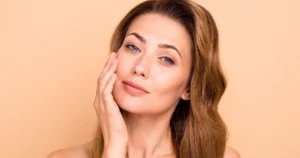When it comes to achieving radiant and youthful skin, there’s no shortage of skincare treatments and products in the market. However, one method that has been gaining significant attention for its ability to unlock luminous skin is dermaplaning. Dermaplaning is a non-invasive exfoliation technique that involves gently scraping off the top layer of dead skin cells and fine facial hair. This comprehensive guide will delve into dermaplaning, exploring what it is, how it works, its benefits, and crucial tips before opting for this treatment.
What is Dermaplaning?
Dermaplaning is a cosmetic procedure performed by trained professionals to exfoliate the skin using a surgical scalpel. The treatment’s main objective is to remove dead skin cells and vellus hair from the skin’s surface. By gently scraping away these layers, dermaplaning reveals a smoother and brighter complexion, giving the skin a fresh and rejuvenated appearance. This non-invasive and safe procedure has gained popularity in recent years due to its effectiveness in improving the skin’s texture and overall appearance.
How Does Dermaplaning Work?
The dermaplaning process is relatively simple but requires expertise to achieve optimal results. The treatment typically occurs in a professional setting, such as a spa or dermatologist’s office. Before starting the procedure, the esthetician thoroughly cleanses the face to remove any makeup, oils, or impurities. Once the skin is clean and dry, the esthetician uses a sterile surgical scalpel held at a 45-degree angle to scrape the skin’s surface gently. They use upward strokes to exfoliate and effectively remove dead skin cells and vellus hair. The treatment usually takes around 30 minutes, and no downtime or recovery period is required.
The Benefits of Dermaplaning
a. Enhanced Skin Texture: One of the most noticeable benefits of dermaplaning is its ability to enhance the skin’s texture. By removing the outer layer of dead skin cells, which can sometimes create a rough or uneven surface, dermaplaning leaves the skin feeling smoother and softer.
b. Brighter Complexion: Removing dead skin cells and vellus hair contributes to a brighter complexion. After dermaplaning, the fresh and radiant skin underneath is revealed, making the face look more vibrant and youthful.
c. Better Product Absorption: Dermaplaning can significantly improve the absorption of skincare products. With the top layer of dead skin cells gone, the active ingredients in serums, moisturizers, and other skincare products can penetrate more effectively into the skin, maximizing their benefits.
d. Reduction of Fine Lines and Wrinkles: While dermaplaning is primarily an exfoliation treatment, its impact on the skin’s surface can lead to a reduction of fine lines and wrinkles. By promoting skin cell turnover, dermaplaning encourages the production of collagen and elastin, which are essential for maintaining skin elasticity and firmness.
e. Makeup Application: Dermaplaning can be a game-changer for makeup enthusiasts. After the treatment, makeup glides smoothly and evenly, creating a flawless finish without clinging to facial hair or dry patches.
f. Safe for Pregnant Women: Pregnant women often worry about using certain skincare treatments that may contain harsh chemicals. Dermaplaning offers a safe and effective exfoliation option for expectant mothers looking to maintain their skin’s glow during pregnancy.
Myths and Misconceptions about Dermaplaning
a. Hair Regrowth Thicker and Darker: One common misconception about dermaplaning is that it causes the regrowth of facial hair to become thicker and darker. However, this is different. Dermaplaning targets vellus hair, which is thin and fine. The treatment does not affect the growth or texture of the hair follicles, so the regrowth remains the same as before the procedure.
b. Only for Certain Skin Types: Another myth surrounding dermaplaning is that it is only suitable for specific skin types. In reality, dermaplaning is a safe and effective treatment for most skin types, including sensitive skin. However, as with any cosmetic procedure, it’s essential to consult a qualified esthetician to ensure it is suitable for your skin’s needs.
c. Causes Acne Breakouts: Some people fear dermaplaning may trigger acne. On the contrary, dermaplaning can help prevent breakouts by removing dead skin cells and unclogging pores. However, following the esthetician’s post-treatment skincare recommendations is crucial to maintaining healthy skin.
Preparing for a Dermaplaning Treatment
a. Consultation with a Professional: Before getting a dermaplaning treatment, it is essential to schedule a consultation with a qualified esthetician. During this consultation, the esthetician will assess your skin type, discuss your skincare concerns, and determine if dermaplaning is the right option.
b. Avoid Sun Exposure: It is advisable to avoid excessive sun exposure before and after the treatment. Sunburned or tanned skin can be more sensitive during dermaplaning, so protecting your skin from the sun’s harmful rays is best.
c. Skincare Routine Adjustments: Leading up to the treatment, you may need to adjust your skincare routine. This could involve avoiding harsh exfoliants and retinol products for a few days before dermaplaning to prevent over-exfoliation and potential skin irritation.
d. Post-Treatment Skincare: After dermaplaning, your skin may be more sensitive. Following the esthetician’s advice on post-treatment skincare is crucial to maintain the results and ensure your skin stays healthy and hydrated.
At-Home Dermaplaning vs. Professional Treatment
While at-home dermaplaning tools are available, it’s essential to understand the difference between professional and DIY treatments. At-home dermaplaning tools may provide a different precision and safety than a professional treatment performed by a trained esthetician. A professional can tailor the treatment to your specific skin needs, ensuring optimal results and minimizing the risk of complications.
Dermaplaning Aftercare and Maintenance
After a dermaplaning treatment, your skin will feel smoother, look brighter, and have a more even texture. However, to maintain these results, proper aftercare and maintenance are essential. Your esthetician will provide specific instructions on how to care for your skin after the treatment. This may include using gentle products, avoiding excessive sun exposure, and following a consistent skincare routine. Additionally, your esthetician will recommend a suitable maintenance schedule for future dermaplaning sessions to keep your skin glowing and healthy over time.
Conclusion
Dermaplaning is a highly effective and sought-after treatment for radiant and youthful skin. Its gentle exfoliation method, removing dead cells and facial hair, offers numerous benefits, including improved skin texture, a brighter complexion, better product absorption, and reduced fine lines and wrinkles. For those seeking to unlock their skin’s full potential without harsh chemicals or extensive downtime, dermaplaning at Noble Clinic is the perfect choice. Noble Clinic has a team of skilled professionals and state-of-the-art facilities, ensuring a safe and personalized dermaplaning experience for everyone. Discover the beauty of radiant skin and embrace the confidence that comes with it. Trust Noble Clinic to help you achieve your skincare goals and uncover a rejuvenated, luminous glow like never before.





